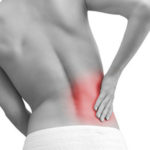
“Lumbago” Anyone?
Chronic Low Back Pain – Gluteus medius and gluteus maximus cause low back pain in multiple ways. These “glute” muscles include the fleshy and outermost gluteus maximus, gluteus medius and the gluteus minimus, deepest of the group. Some also include piriformis and some of the other rotators of the hip. In times past, this problem was often referred to as “lumbago”.
The first step in managing any case of lower back pain is to confirm or eliminate more serious spinal injury or degeneration as a cause. Once these more serious factors are examined we can focus on the soft tissue aspects of chronic lower back pain – glutes are just one them.
Janda's Lower Crossed Syndrome
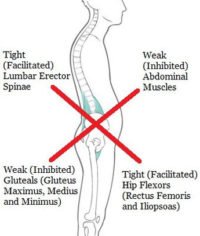 Myofascial dysfunction in the glutes often occurs as part of a larger pattern of imbalance with other hip muscles acting on the hip. This is called Janda's Lower Crossed Syndrome.
Myofascial dysfunction in the glutes often occurs as part of a larger pattern of imbalance with other hip muscles acting on the hip. This is called Janda's Lower Crossed Syndrome.
The "cross" is an imbalance between four different groups of muscles; the iliopsoas/spinal erectors, which are too tight, and the glutes/abdominals, which are too weak.
Correcting this requires treatment and stretching of the hip flexors and spinal erectors. However, this is only addresses half of the problem. It is also necessary to strengthen the glutes and certain abdominal muscles to restore balance to this key area.
Activation of Glute Trigger Points
Trigger points in the gluteus maximus tend to cause pain in the butt and rear of the upper thigh, not the low back. However, a strong gluteus maximus is key to a healthy back. And, myofascial dysfunction in the gluteus maximus is one of causes of weakness in this area. A successful strengthening program may require inactivation of glute max trigger points.
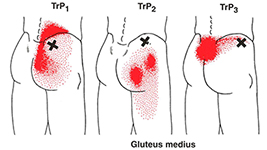 Trigger points in the gluteus medius do refer into the low back. You can activate gluteus medius trigger points by falls, sports injuries, running, hikes in the woods, long walks on sandy beaches or other uneven surfaces and bearing weight on one leg for an extended time.
Trigger points in the gluteus medius do refer into the low back. You can activate gluteus medius trigger points by falls, sports injuries, running, hikes in the woods, long walks on sandy beaches or other uneven surfaces and bearing weight on one leg for an extended time.
However, in 21st century life, inactivity and prolonged hip flexion from sitting with poor seating are the number one cause of problems with gluteus medius.
What Makes This Type of Glute Pain Worse?
Seating is a big deal. Prolonged flexion at the hip aggravates trigger points in the glutes. For example, typical desk seating or sleeping in the fetal position flex the hips. Sitting on a wallet or cell phone can cause sustained pressure on the gluteus medius, leading to trigger points.
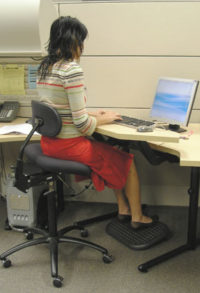 In fact, sitting in any position for a long time can irritate your glutes. You may also find that crossing your legs aggravates your glutes. If you tend to cross your legs, you this may suggest an asymmetry of your pelvis that can be easily corrected.
In fact, sitting in any position for a long time can irritate your glutes. You may also find that crossing your legs aggravates your glutes. If you tend to cross your legs, you this may suggest an asymmetry of your pelvis that can be easily corrected.
When sitting for prolonged periods, try to modify your seating so that your the angle of your hips is more open. The sloping chair pictured is just one of a variety of ways you can achieve this. This type of seating is a better alternative than standing for many office workers.
Consider using a rocking lounger or even old-fashioned rocking chair at home. It reduces immobility while sitting and promotes muscular relaxation. When driving, cruise control will provide you the opportunity to move a bit over extended distances. For those who sleep on their side it is important to avoid sleeping in the fetal position, with the hips sharply flexed.
How Therapy can Help With Low Back Pain
The various glutes influence the low back in a variety of ways.
Trigger points in the glutes often occur as part of a larger pattern of imbalance and myofascial dysfunction.
Most of us are busy, so designing a program that will provide the most benefit with the least time and effort expended is important.
Extra – Details on Gluteus Maximus and Medius!
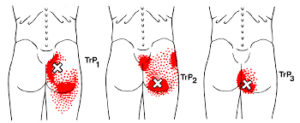 Trigger points in the gluteus maximus can refer pain and other symptoms to the sacrum and tailbone area, the lower buttock and the upper, outside area near the hip.
Unlike the radiating referrals of the other glutes, TrPs in the gluteus maximus tends to remain local.
You may experience pain when sitting if you have gluteus maximus trigger points, trying to avoid pressure or lean to the opposite side. You may squirm in your seat to prevent discomfort.
Gluteus maximus TrPs can also cause pain when walking, especially uphill. The forward lean of your trunk can overload the gluteus maximus. These symptoms can be similar to sacroiliac inflammation.
Pain from TrPs in this muscle intensifies with vigorous contractions of a muscle that is already shortened—for instance, kicking while swimming can cause this, especially in cold water.
The explosive starts typical of tennis, beach volleyball, or sprints can overload your gluteus maximus, resulting in symptoms similar to an upper hamstring strain.
Trigger points in the gluteus maximus can refer pain and other symptoms to the sacrum and tailbone area, the lower buttock and the upper, outside area near the hip.
Unlike the radiating referrals of the other glutes, TrPs in the gluteus maximus tends to remain local.
You may experience pain when sitting if you have gluteus maximus trigger points, trying to avoid pressure or lean to the opposite side. You may squirm in your seat to prevent discomfort.
Gluteus maximus TrPs can also cause pain when walking, especially uphill. The forward lean of your trunk can overload the gluteus maximus. These symptoms can be similar to sacroiliac inflammation.
Pain from TrPs in this muscle intensifies with vigorous contractions of a muscle that is already shortened—for instance, kicking while swimming can cause this, especially in cold water.
The explosive starts typical of tennis, beach volleyball, or sprints can overload your gluteus maximus, resulting in symptoms similar to an upper hamstring strain.
 Pain in the buttocks can also be caused by lumbar disc and facet pathologies, sacroiliac joint dysfunction, coccynynia or hip joint problems.
However, some diagnosed with trochanteric bursitis, including those treated successfully with a local anesthetic, actually have gluteus maximus TrPs that area.
You can perform self-pressure release with a Backknobber, a lacrosse ball or tennis ball. If your glutes are very sensitive, you may even need to start with a larger fitness ball. If you can, try holding up your weight to moderate the pressure between the floor and your glutes. If you find it more comfortable, you can apply the same technique against a wall.
Hold pressure for 15-25 seconds, repeating for up to six repetitions. This can be done as up to every two to three hours, as long as your symptoms are still being relieved. Be cautious not to use too much pressure. This can activate or perpetuate trigger points.
If you have gluteus maximus TrPs you should avoid prolonged sitting. If you work with a computer, you should request an ergnonomic assessment and modifications to your workstation.
It is best to have a desk that is adjustable between standing and sitting, with a chair to match. It should also have adjustable arm rests and lumbar supports. Pay special attention to the fabric and padding of the seat. Move frequently!
Side sleeping with the painful side up and a thick pillow between your knees can reduce symptoms and improve sleep quality.
Pain in the buttocks can also be caused by lumbar disc and facet pathologies, sacroiliac joint dysfunction, coccynynia or hip joint problems.
However, some diagnosed with trochanteric bursitis, including those treated successfully with a local anesthetic, actually have gluteus maximus TrPs that area.
You can perform self-pressure release with a Backknobber, a lacrosse ball or tennis ball. If your glutes are very sensitive, you may even need to start with a larger fitness ball. If you can, try holding up your weight to moderate the pressure between the floor and your glutes. If you find it more comfortable, you can apply the same technique against a wall.
Hold pressure for 15-25 seconds, repeating for up to six repetitions. This can be done as up to every two to three hours, as long as your symptoms are still being relieved. Be cautious not to use too much pressure. This can activate or perpetuate trigger points.
If you have gluteus maximus TrPs you should avoid prolonged sitting. If you work with a computer, you should request an ergnonomic assessment and modifications to your workstation.
It is best to have a desk that is adjustable between standing and sitting, with a chair to match. It should also have adjustable arm rests and lumbar supports. Pay special attention to the fabric and padding of the seat. Move frequently!
Side sleeping with the painful side up and a thick pillow between your knees can reduce symptoms and improve sleep quality.
Stretching
Stretching should always be done as part of myofascial self-pressure release. Whenever we treat a muscle, we want to run it through its entire range of motion, and this often a includes a stretch. Difficulty with these basic stretches is also a sign of dysfunction in the glutes.
One of the best ways to stretch gluteus maximus is with a knee to chest stretch. This can be done seated in a chair or on the floor or lying on your back.
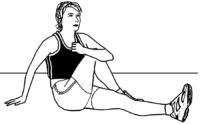
Note that to get a thorough stretch, you will also need to cross the knee across your chest, as in this seated stretch. This is because gluteus maximus is an adductor and external rotator, as well as extensor, of your hip. We want to stretch it in each of those dimensions.
Retraining
There are various circumstances that can cause your gluteus maximus and other muscles to mis-fire, fire weakly or fire out of order. In many cases of chronic low back pain, glute weakness reduces stability and increases pain.
However, we may not be able to strengthen the glutes because 1) there may be active trigger points that need to be cleared first and 2) the glutes may need re-training to fire effectively. This is simple process. Although a trained therapist is best equipped to evaluate glute firing the method of re-training is simple an well illustrated by this video.
In many cases, effective glute strengthing is not possible without retraining.
Therapeutic Strengthening
In general, muscles with active trigger points or other myofascial dysfunction can’t be effective strengthed. Make sure that you have released any active trigger points, can move the muscle through its entire range of motion and that the muscle fires properly before attempting to therapeutic strength training.
In adults of all ages, there is a significant mixture of type I slow twitch and type II fast twitch fibers in gluteus maximus – approximately 70%/30%.
The means that effective strength training requires both high speed repetitions with less load and slower repetitions with a greater load are necessary.
For example, you may choose to cycle vigorously for 10 minutes. This is example of a exercise that targets the type II, fast twitch fibers in gluteus maximus.
In addition, you may also have been trained to perform a glute bridge. This exercise, performed more slowly and with more load, targets the type I fibers of your gluteus maximus.
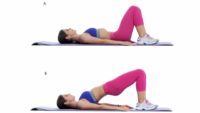 First, re-establish your breath. Then squeeze the glutes together and imagine the glutes pushing the spine up, rather than the quads and abs pulling it it.
First, re-establish your breath. Then squeeze the glutes together and imagine the glutes pushing the spine up, rather than the quads and abs pulling it it.
Hold for one slow breath and lower VERY slowly. Imagine placing one vertabra at a time down on the flow as you descend.
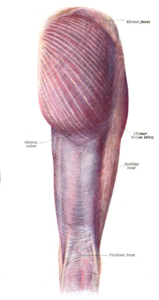 The gluteus maximus (also known collectively with the gluteus medius and minimus, and sometimes referred to informally as the "glutes") is the main extensor muscle of the hip. It is the largest and exterior-most of the three gluteal muscles and makes up a large portion of the shape and appearance of each side of the hips. Its thick fleshy mass, in a quadrilateral shape, forms the prominence of the buttocks. Its average weight of 844g is more than twice that of the other glutes together and it often measures 2.5cm (1 inch) thick.
The gluteus maximus (also known collectively with the gluteus medius and minimus, and sometimes referred to informally as the "glutes") is the main extensor muscle of the hip. It is the largest and exterior-most of the three gluteal muscles and makes up a large portion of the shape and appearance of each side of the hips. Its thick fleshy mass, in a quadrilateral shape, forms the prominence of the buttocks. Its average weight of 844g is more than twice that of the other glutes together and it often measures 2.5cm (1 inch) thick.
Organization
The gluteus maximus is larger and more extensive in humans than any other primate. In adapting to bipedal gait, reorganization of the attachment of the muscle as well as the moment arm was required. Some of these evolutionary changes include shortening and tilting of the pelvis to permit extension of the thigh, a more horizontal angulation of the muscle and significant enlargement compared to other primates. This structure supports the upright posture and and bipedal walking of humans. Humans are the only mammal that can place the center of mass of our head, arms and torso over our hips. The evolutionary change presumably freed our hands for other activities are believed to be crucial to the development of manual dexterity and intelligence in humans. The muscle is remarkably coarse in function and structure, made up of muscle fascicles lying parallel with one another, and collected together into larger fibrous bundles.Structure
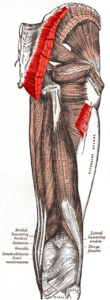 It arises from the posterior gluteal line of the inner upper pelvic bone, and roughly the portion of the bone including the crest of the hip bone, immediately above and behind it; and from the posterior surface of the lower part of the sacrum, the base of the spine, and the side of the coccyx, the tailbone; from the aponeurosis of the erector spinae (lumbodorsal fascia), the sacrotuberous ligament, and the fascia covering the gluteus medius (gluteal aponeurosis). The fibers are directed obliquely downward and lateralward; The gluteus maximus has two insertions:
It arises from the posterior gluteal line of the inner upper pelvic bone, and roughly the portion of the bone including the crest of the hip bone, immediately above and behind it; and from the posterior surface of the lower part of the sacrum, the base of the spine, and the side of the coccyx, the tailbone; from the aponeurosis of the erector spinae (lumbodorsal fascia), the sacrotuberous ligament, and the fascia covering the gluteus medius (gluteal aponeurosis). The fibers are directed obliquely downward and lateralward; The gluteus maximus has two insertions:
- those forming the upper and larger portion of the muscle, together with the superficial fibers of the lower portion, end in a thick tendinous lamina, which passes across the greater trochanter, and inserts into the iliotibial band of the fascia lata;
- the deeper fibers of the lower portion of the muscle are inserted into the gluteal tuberosity between the vastus lateralis and adductor magnus.

Active trigger points in gluteus medius cause pain when bearing weight – whether standing, walking, running or climing stairs. Standing is particularly uncomfortable, and you are likely to shift your weight back and forth to give the painful leg a break.
Transitions from sitting to standing are difficult. Getting in and out of a car can be particularly painful. Typically, sleeping on the affected side is also painful.
Trigger points in the gluteus medius refer into the low back.This pain runs along the beltline on the affected side. It can be disabling and interfere with activities of daily living.
You can activate gluteus medius trigger points by falls, sports injuries, running, hikes in the woods, long walks on sandy beaches or other uneven surfaces and bearing weight on one leg for an extended time. Gluteus medius TrPs are often cause low back and hip pain during the later stages of pregnancy.
However, in 21st century life, inactivity and prolonged hip flexion from sitting with poor seating are the number one cause of problems with gluteus medius.
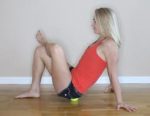 You can perform self-release of the gluteus medius easily. Many illustrations show the use of a tennis or lacrosse ball when laying down to compress the glutes. Most glute problems occur as a group so, consider your other glutes and related muscles too.
You can perform self-release of the gluteus medius easily. Many illustrations show the use of a tennis or lacrosse ball when laying down to compress the glutes. Most glute problems occur as a group so, consider your other glutes and related muscles too.
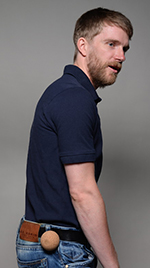 We prefer to perform this type of self-compression when standing, against a wall. In this illustration against a clear ‘wall’, we suggest using two balls and putting them in a sock. That way you have a “handle” to hold on to when you drop the balls. They also won’t roll away.
We prefer to perform this type of self-compression when standing, against a wall. In this illustration against a clear ‘wall’, we suggest using two balls and putting them in a sock. That way you have a “handle” to hold on to when you drop the balls. They also won’t roll away.
If you stand on one foot to get dressed, you may catch yourself. Putting on socks/hose, pants, shorts or skirts, catching your foot may throw you off balance.
The sudden acute overload will often activate gluteal trigger points even though you didn’t fall. It happens to almost everyone occasionally. Try to make a habit of sitting down or leaning against the wall when you get dressed.
Stretching
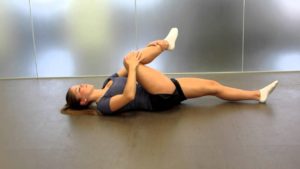 Stretching should always be done as part of myofascial self-pressure release. Whenever we treat a muscle, we want to run it through its entire range of motion, and this often a includes a stretch. Difficulty with these basic stretches is also a sign of dysfunction in the glutes.
Stretching should always be done as part of myofascial self-pressure release. Whenever we treat a muscle, we want to run it through its entire range of motion, and this often a includes a stretch. Difficulty with these basic stretches is also a sign of dysfunction in the glutes.
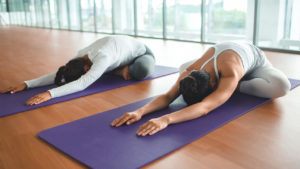 As you can see in these two stretches, we’re stretching in opposite directions. They are both correct, because like the other glutes, there are two sections to this muscle. The anterior, middle and posterior fibers are stretched in the first photo and the middle and anterior fibers are stretched in the second one.
As you can see in these two stretches, we’re stretching in opposite directions. They are both correct, because like the other glutes, there are two sections to this muscle. The anterior, middle and posterior fibers are stretched in the first photo and the middle and anterior fibers are stretched in the second one.
This reflects the fact that gluteus minimis is both a significant internal rotator of the thigh at the hip as well as an external rotator. However, given the primary function of gluteus medius as an abductor of the hip, the first stretch seems more fundamental. The pigeon variation showing external variation actually shortens most of the gluteus medius muscle. Ideally, two stretches like this are performed together.
Muscle Retraining
As with gluteus maximus, your gluteus medius may not be firing correctly. In this case, retraining of the muscle is essential as part of any rehab program.
Therapeutic Strengthening
A casual persusal of the Internet will reveal at least a half a dozen major types of gluteus medius exercises. Some of them are simply wrong. Some of them are OK for healthy, fit people but not recommended for rehab. At best, some of them advise strengthening the gluteus medius while balancing one leg- a literal prescription for activating TrPs in the muscle!
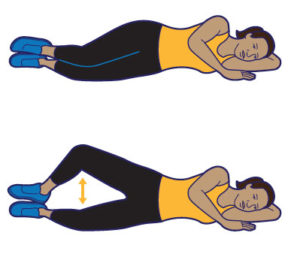
Begin by establishing a deep, diaphragmatic breath. The clamshell exercise, performed with the back against the wall, is a safe and conservative intro to strengthening gluteus medius.
First, this strengthens the important abduction aspect of the gluteus medius. Second, the flexed hip position takes the TFL out of the equation and isolates the gluteus medius. That means that you can deepen the exercise by extending your knee, increasing the moment on the hip. Keep your hip flexed to keep the TFL inactive.
While making the same basic movement, you can work the internal and external rotation aspects of the muscle. To do this, slightly rotate the knees in as you close the clamshell and rotate slightly externally as you open.
Finally, you can safely extend this work by opening the clamshell and ‘kicking out’ diagonally up and forward. If you were laying square to the room, you would be kicking towards an upper corner of the room.
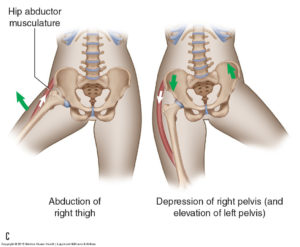 Gluteus medius adDucts (moves away) the thigh from the midline of the body at the hip, particularly when the hip is flexed. Think clamshell exercises. It also assists in other movements of the hip. However, gluteus medius can refer powerfully into the low back.
Gluteus medius adDucts (moves away) the thigh from the midline of the body at the hip, particularly when the hip is flexed. Think clamshell exercises. It also assists in other movements of the hip. However, gluteus medius can refer powerfully into the low back.
The anterior part acting alone helps to flex and internally rotate the hip.
The posterior part acting alone helps to extend and externally rotate the hip.
The anterior and posterior parts working together abduct the hip and stabilize the pelvis in the coronal plane.
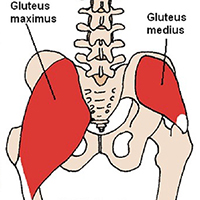 The gluteus medius, one of the three gluteal muscles, is a broad, thick, radiating muscle. It is situated on the outer surface of the pelvis.
The gluteus medius, one of the three gluteal muscles, is a broad, thick, radiating muscle. It is situated on the outer surface of the pelvis.
Its posterior third is covered by the gluteus maximus, its anterior two-thirds by the gluteal aponeurosis, which separates it from the superficial fascia and integument.
Structure
The gluteus medius muscle starts, or “originates,” on the outer surface of the hip bone between the iliac crest and the posterior gluteal line above, and the anterior gluteal line below. The gluteus medius also originates from the gluteal aponeurosis that covers its outer surface.
The fibers of the muscle converge into a strong flattened tendon that inserts on the lateral surface of the greater trochanter.
Variations
The posterior border may be more or less closely united to the piriformis, or some of the fibers end on its tendon.
The posterior fibres of gluteus medius contract to produce hip extension, lateral rotation and abduction. During gait, the posterior fibres help to decelerate internal rotation of the femur at the end of swing phase.
Gluteus medius adDucts (moves away) the thigh from the midline of the body at the hip, particularly when the hip is flexed. Think clamshell exercises. It also assists in other movements of the hip. However, gluteus medius can refer powerfully into the low back.

